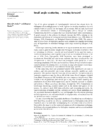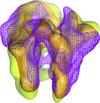issue contents
June 2012 issue

Cover illustration: Electron-density map of Na+-translocating NADH:ubiquinone oxidoreductase from the human pathogen Vibrio cholerae at a resolution of 16 Å, calculated by ab initio phasing (p. 724). Projection of ab initio-phased electron-density synthesis along the crystallographic axis c. The unit cell is indicated by a red box.
editorial
Free 

scientific comment
Free 

This article presents a set of preliminary publication guidelines for structural modelling of small-angle scattering data from biomolecules in solution, and discusses the rationale for their application.
research papers
The structures of formylglycinamide ribonucleotide amidotransferase from S. typhimurium either with an unliganded glutaminase domain or in complex with an ATP analogue revealed that no major conformational changes take place upon formation of the glutamyl thioester intermediate or subsequent ATP complexation; therefore, formylglycinamide ribonucleotide binding is proposed to be the mechanism of activation of catalytic coupling in the enzyme.
Fam96a is a mammalian DUF59 protein, but its structure diverges from those of bacterial DUF59 proteins. Structural clues suggest similarities between Fam96a and amyloidogenic proteins.
Much more accurate anomalous signal and greater success in substructure determination can be obtained by merging data from multiple crystals preselected according to the results of cluster analysis.
The crystal structure and biochemical properties of the C-terminal catalytic domain of SSV1 integrase, an archaeal member of the tyrosine recombinase family, are described.
Crystal structures of aspartate semialdehyde dehydrogenase from Mycobacterium tuberculosis in complex with glycerol and with cysteine are presented.
The crystal structure of human RSK1 C-terminal kinase domain (CTKD) is reported at 2.7 Å resolution. The structure indicates that the autoinhibition of the CTKD is caused by an α-helix occupying the substrate-binding groove.
PDB reference: human RSK1 CTKD, 3rny
The crystal structure of ShSPI, a serpin from the blood fluke S. haematobium, reveals some peculiar features of the helical subdomain which have not been observed previously in the serpin superfamily.
PDB reference: ShSPI, 3sto
Crystal structures of factor XIIa inhibitor infestin 4 and infestin 1–trypsin complex have been refined at 1.4 and 2.5 Å resolutions, respectively. Mutants of infestin 4 highly specific to factor XIIa were selected by phage display.
D. radiodurans AlkA consists of only two domains instead of three as for E. coli AlkA. This structural modification alters the substrate specificity which may contribute to an improved DNA-repair repertoire of this extreme radiation resistant organism.
1.40 and 1.26 Å resolution crystal structures of potato endo-1,3-β-glucanase, a member of glycoside hydrolase family 17, reveal high flexibility of a subdomain that forms part of the active-site cleft and an unusual crystal-packing mode characterized by infinite chains of protein molecules linked via His-tag docking in the next active site.
A 16 Å resolution molecular envelope of Na+-translocating NADH:ubiquinone oxidoreductase was determined by connectivity-based ab initio phasing. The low-resolution structure of this multi-subunit membrane complex was confirmed by negative-stain electron microscopy.
short communications
The distribution of twinned intensities may be biased towards the Wilson distribution if a noncrystallographic screw axis parallel to the twinning axis is present.


 journal menu
journal menu






























